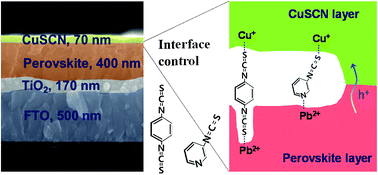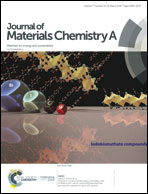Enhancement of open circuit voltage for CuSCN-based perovskite solar cells by controlling the perovskite/CuSCN interface with functional molecules†
Abstract
CuSCN, a low-cost inorganic hole transporting material (HTM), exhibits notably high hole-mobility and material stability, but turns out to show significantly lower open circuit voltage (VOC) than organic hole-conductors in its application as an HTM in perovskite solar cells (PSCs). Herein, for the enhancement of VOC, various functional molecules were introduced on the surface of a CH3NH3PbI3 (MAPbI3) layer to passivate the defects and to improve the contact between MAPbI3 and CuSCN layers. In particular, by introducing a mixture of 3-pyridyl isothiocyanate (Pr-ITC) and phenylene-1,4-diisothiocyanate (Ph-DITC), the VOC of the CuSCN-based PSC (PSC-CuSCN) was increased over 40 mV, due to their unique molecular structures possessing two separate functional groups that can interact with MAPbI3 as well as CuSCN. By this interfacial treatment, the fabricated CuSCN-based PSC device exhibits an average photovoltaic conversion efficiency (PCE) of 18.57% (PCE of 19.17% for the champion device), which is very close to the photovoltaic performance of the PSC with spiro-OMeTAD (PSC-spiro, average PCE of 19.03%). Also, the hysteresis in J–V measurements has been minimized, suggesting no appreciable charge accumulation at the perovskite/CuSCN interface by successful passivation of defects. Moreover, the long-term stability of PSC-CuSCN devices was further improved: after 200 days at a relative humidity of 30 ± 5%, 86% of the initial PCE remained for the PSC-CuSCN with surface treatment, whereas only 73% and 56% remained for the bare PSC-CuSCN and PSC-spiro, respectively.



 Please wait while we load your content...
Please wait while we load your content...